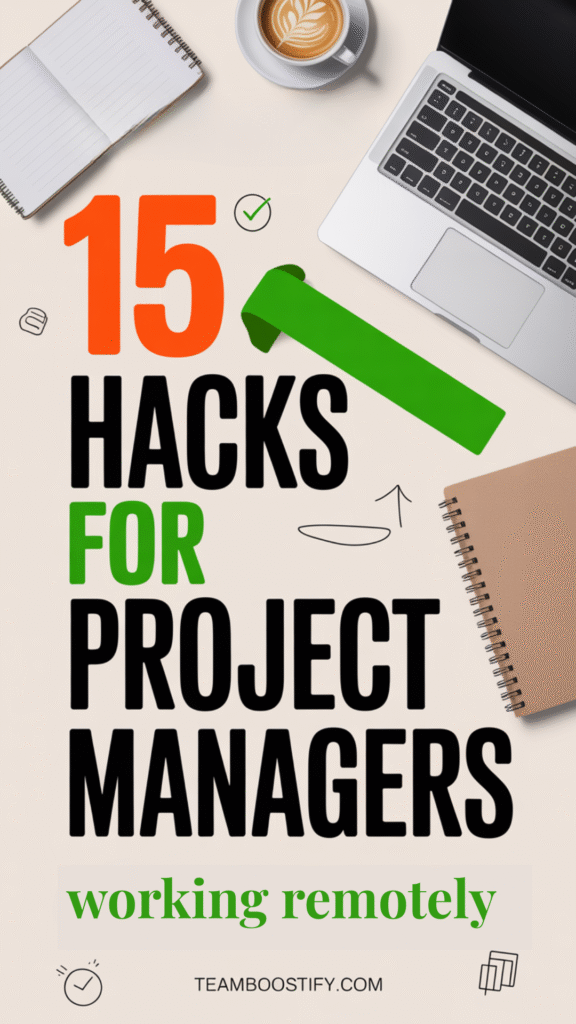One of the best chapters of my career was working in a PMO team at a consulting company. My tasks were all over the place: writing procedures and project templates, approving commercial proposals on behalf of the Delivery Department, and managing internal strategic projects. And all of this – fully remote, with a newborn at home. It was intense, sometimes messy, but looking back, it gave me some of my strongest lessons about work from home productivity.
Later, when I was invited as a guest speaker, I reflected on that time and realized: I had actually shaped a simple set of criteria that made remote work not just possible, but productive. They’re especially useful if you’re:
- considering a remote role and want to know if it will really fit your life, or
- already working remotely, but feel something’s off and can’t put your finger on it.
The list I’m sharing here is based on my own experience of juggling multiple roles. But many of these points are universal – practical for anyone who wants to make work from home productivity sustainable in the long run.
Table of Contents
First Group of Work From Home Productivity Criteria: Work
The first thing to check for work from home productivity is the job itself. Tools and setups are nice, but if the role doesn’t fit remote work, no schedule hack will save it. What matters are the demands and expectations — things like flexibility, predictability, and how the team works together.
When I looked at my own roles, asking a few simple questions upfront made all the difference. It showed me whether remote work would feel smooth or whether I’d be constantly fighting against the job.
1.1 How flexible is the schedule?
This was my number one. Flexibility determined whether I could survive as both a project professional and a new mom.
In practice, I built a two-shift day. From 5 to 9 a.m., while my baby was still asleep, I handled solo tasks: writing procedures, preparing presentations, or reviewing project templates. Then, once colleagues came online, I switched into collaboration mode — calls, discussions, approvals. That mix allowed me to meet deadlines and stay sane.
What I learned: don’t just assume flexibility exists. Some roles are tied to rigid hours, others give you freedom. The only way to know is to ask upfront:
- Do I have control over when I do the work, as long as it gets done?
- Or does my manager expect me to be online 9–6 no matter what?
And here’s the tricky part: sometimes managers believe they offer flexibility, but in reality the culture punishes people who step outside “core hours.” Better to surface those expectations early than discover them in week two.
1.2 How predictable are the tasks?
The second factor I looked at was predictability. A role that’s 80% planned and 20% surprises feels very different from one that’s 80% emergencies and only 20% stable.
Back then, my PMO role had a good balance. Sure, last-minute requests came in — “can you review this proposal today?” — but most of my work was projectable: building processes, tracking initiatives, preparing reports. That made it possible to align with my family’s rhythm.
The problem with highly unpredictable roles is that they collide with carefully arranged routines. Imagine you’ve set up childcare for three focused hours, and then an “urgent” request wipes them out. One day it’s fine; every day, it’s burnout.
So, I asked:
- How often do true emergencies happen in this role?
- What percentage of my time will be firefighting versus planned work?
Neither setup is “good” or “bad.” Some people thrive on unpredictability. But for me, in that season of life, high stability was the only way remote work could work.
1.3 What’s my relationship with the manager and team?
Remote work lives and dies on trust. If trust is strong, small misunderstandings get solved quickly. If it’s weak, every misstep feels like a crisis.
I was lucky: in my PMO role, I already had strong working relationships. That foundation made remote collaboration smooth, even when things got messy. I could miss a call without anyone suspecting I was “slacking.” They knew I was reliable.
If you don’t have that trust, remote can feel like constant proving-yourself. Daily check-ins turn into micromanagement. Slack messages feel like surveillance. So, this was a key criterion for me:
- Do I have enough trust with my manager and colleagues to make distance work?
If not, you’ll spend more energy managing perceptions than managing actual work.
1.4 How does the company get things done?
Every company has its “default mode.” Some rely heavily on in-person conversations and hallway chats. Others are fully comfortable with digital workflows.
For me, this showed up in meetings. I needed a setup where cameras weren’t mandatory. As a new mom, there were mornings when I was juggling both work and baby care. Prioritizing delivery over appearances mattered more to me than having perfect lighting on Zoom. Luckily, my company culture didn’t demand “camera on” all the time, and that gave me breathing space.
Here are some questions worth asking yourself:
- Is the company’s culture supportive of asynchronous communication, or does everything require instant responses?
- Are digital tools integrated into the workflow, or is remote still treated as a “second-class” option compared to being in the office?
If the processes clash with remote reality, you’ll feel it in endless frustration.
1.5 How will my productivity be measured?
Finally, the question of evaluation. This one matters more than people think.
In roles where outcomes matter most — projects delivered, documents prepared, deadlines met — remote work is empowering. You feel trusted. In roles where every hour must be logged and reported, remote quickly turns toxic.
In my PMO experience, I had both. On strategic projects, results were the measure: deliver the process, finalize the template, support the initiative. But on some tasks, micromanagement crept in — “log every call,” “show progress every hour.” The contrast was stark.
So, I always asked myself:
- Will I be measured on outputs, or controlled through inputs?
- Does the company have a culture of trust, or of suspicion?
Because no matter how skilled you are, constant reporting drains energy and kills productivity.
Second Group of Work From Home Productivity Criteria: Me
A lot of work from home productivity comes down to you. Without the structure of an office, your own habits and energy matter more than any fancy tool or setup. If they don’t fit the rhythm of remote work, even a good role can feel harder than it should.
For me, asking a few honest questions about motivation, health, and routines made a big difference. It didn’t solve everything, but it helped keep my work from home productivity steady, even on the messy days.
2.1 Do I have the motivation?
Motivation isn’t something you can fake. Either it’s there or it isn’t.
When I returned from maternity leave, I was bursting with motivation. I needed the work for financial reasons, but also for my own sanity. After months of being fully at home with a baby, I was ready to put my energy into projects again. That drive was the foundation — on the tough days, it kept me moving.
If the motivation isn’t strong, remote work can feel like a slog. There’s no office energy to carry you, no daily commute to mark “I’m at work now.” You need an inner engine.
So I asked: Why do I want this remote role? Is it necessity, career growth, or lifestyle? And will that “why” still hold six months from now?
2.2 Is my health ready for this?
Remote work doesn’t magically make life easier. If anything, it can blur lines and add extra strain.
At that time, my health wasn’t perfect: I was sleep-deprived, breastfeeding, and juggling night wake-ups. But I still needed to check honestly — can I sustain the workload without breaking myself?
The reality is, if your body is already running on empty, remote can drain you further. You may end up working at odd hours, skipping breaks, and carrying stress into your personal life.
For me, one practical help was finding small recovery tools: short walks, guided meditations, even just ten minutes of breathing between calls. They didn’t fix the exhaustion, but they stopped it from snowballing.
2.3 What are my personal traits?
This one is underestimated, but huge. Remote work makes your natural tendencies very visible.
For me:
- I’m an early bird. My most productive hours are 5–8 a.m. After 8 p.m.? Forget it — my brain shuts down.
- I’m an extrovert. I get energy from talking to people, so remote work without regular calls would have been draining.
Knowing that, I planned accordingly. I scheduled deep work early mornings, collaboration mid-day, and avoided evening commitments.
If you’re an introvert, maybe remote is easier — fewer interruptions. If you’re a night owl, maybe late shifts work best. The point is: don’t fight your wiring. Work with it.
2.4 Can I adjust my routine?
Remote roles rarely fit neatly into a perfect day. I had to accept that my old routines wouldn’t survive.
The adjustment for me was waking up at 5 a.m. It wasn’t glamorous, but it was the only way to have quiet focus time before family life kicked in. That shift made everything else possible.
So I asked: Am I willing to reshape my day to fit the role, or am I expecting the role to adapt to me?
2.5 What kind of environment do I need to focus?
Some people absolutely need silence, a door that closes, and zero distractions. I wasn’t one of them. Growing up in a small apartment, I learned to tune things out and could work from the kitchen table for years.
Still, it helped to be clear on my non-negotiables: stable internet, a reliable laptop, and a corner where I could focus. Later, I added noise-canceling headphones — life-changing for concentration.
This question is personal: What conditions do I need to actually deliver? Be honest with yourself before you dive into remote.
2.6 Do I have support?
Remote work can look independent, but nobody does it alone.
I knew I couldn’t manage calls, deadlines, and childcare without help. My family stepped in: my husband and mother-in-law covered certain hours so I could focus. Without that, I’d have been in constant firefighting mode.
The support doesn’t have to be family. It could be childcare, a babysitter, or even a friend who swaps favors. The point is: don’t assume you’ll manage 100% solo.
2.7 What compromises am I willing to make?
This was one of the toughest, but most liberating questions.
Remote work sounds like “work-life balance,” but in reality it’s a series of trade-offs. For me, daily walks were non-negotiable — they reset my energy. But the house? Not spotless. Dishes sometimes waited, and that was fine.
Other compromises might be fewer workouts, less social time, or adjusting expectations with your partner. The key is: decide what’s sacred, and what can slide for a while.
Third Group of Work From Home Productivity Criteria: Environment
The last piece of work from home productivity is your environment. You can have a remote-friendly role and good self-organization, but if the people or setup around you don’t support it, every day turns into a struggle.
For me, it came down to family expectations, basic infrastructure like internet and power, and having a backup plan. Checking those things upfront made remote work a lot less stressful and a lot more sustainable.
3.1 How will this affect my family life?
Remote work doesn’t happen in a vacuum — your family feels it, too.
When my child was one, silence was basically impossible. Nap times helped, but anyone who’s lived with a toddler knows that quiet “windows” can end faster than your sentence. As my child grew, the dynamic changed. At five, I could say: “Mommy’s on a call — can you draw next to me for a bit?” and sometimes it worked. Sometimes not, but still better than at one.
The other piece was honest conversations with my husband and mother-in-law. I needed their buy-in. If they saw my remote work as “just sitting at the computer,” it wouldn’t work. We had to agree: during key calls, they’d step in, and I’d cover family needs at other times.
This is where many remote setups collapse — if family expectations don’t align, frustration builds on both sides. So, I always ask:
- How will my schedule affect the family rhythm?
- Do they see my work as “real,” or just something flexible they can interrupt anytime?
3.2 Do I have the right infrastructure?
The second piece is less emotional, more technical — but just as critical.
For me, the non-negotiables were:
- Stable internet. Sounds obvious, but if your Wi-Fi crashes every time someone streams cartoons, you’ll lose hours and patience fast.
- Reliable power. At the time, power cuts were common where I lived. My husband eventually got a generator. It wasn’t cheap, but without it, I couldn’t have managed critical deadlines.
- Communication tools. I had colleagues in another city, and phone calls weren’t always over the internet. Switching to an unlimited calling plan removed constant stress about minutes. Small change, big relief.
This is the boring, practical side of remote work. It’s easy to overlook, but if the basics fail, no productivity hack will save you.
So I asked myself:
- What tech or setup is absolutely essential for me to work without constant frustration?
- Do I have backups for the weak spots (power, Wi-Fi, hardware)?
3.3 Do I have a backup plan?
Even with support and tech, things will go wrong. Childcare falls through, deadlines clash, or the internet dies right before a big call.
For me, peace of mind came from knowing exactly who could step in. If I had a critical meeting, my husband or mother-in-law would take over childcare. If the power went out, the generator kicked in. If my laptop failed, I had access to a second one.
It didn’t mean everything was smooth — but I wasn’t constantly on edge. I had a plan B. And sometimes even plan C.
The question I learned to ask was simple: When (not if) something breaks, what’s my safety net?
Work from home productivity doesn’t come from apps or perfect desks — it comes from three areas working together:
- Work – is the role itself remote-friendly? Do expectations, trust, and processes support you?
- Me – do your motivation, health, and habits match the demands of remote work?
- Environment – do family, tools, and backups make your setup sustainable?
When one of these falls out of balance, remote work feels heavy. When all three line up, it actually works — not just on paper, but in real life.
If you found this useful, you might also like other posts for project managers on the blog:
- 10 Project Management Top Skills for PMs to Stay Valuable
- 10 Key Meeting Facilitation Skills to Boost Team Performance
- 55 Inspiring Being a Good Leader Quotes for Project Managers
And if you enjoy collecting practical tips and tools, feel free to follow me on Pinterest at @Julia_PM_Facilitator — that’s where I share ideas you can actually use.



